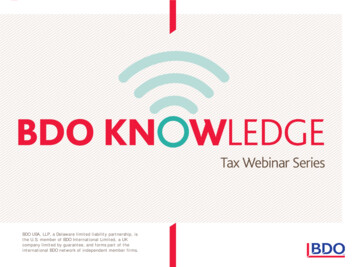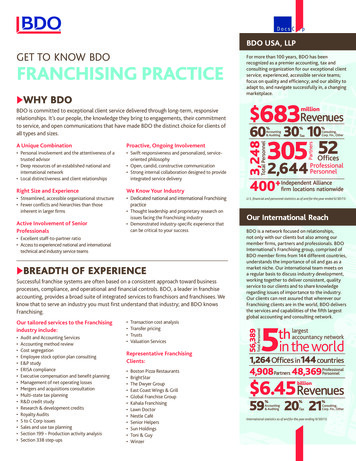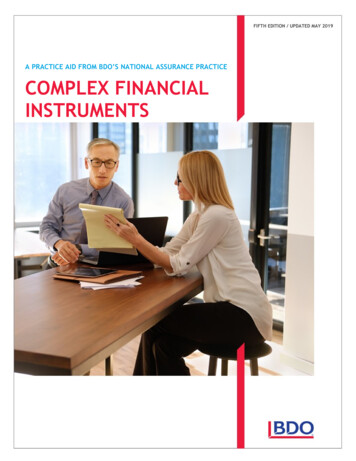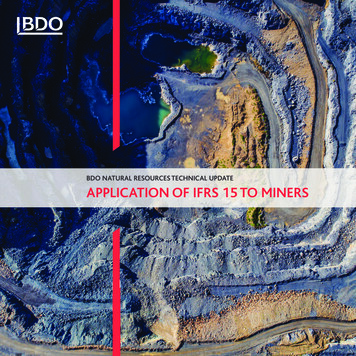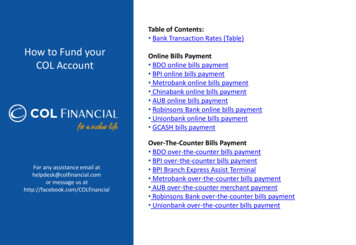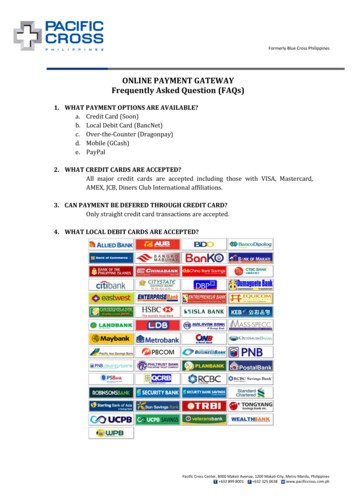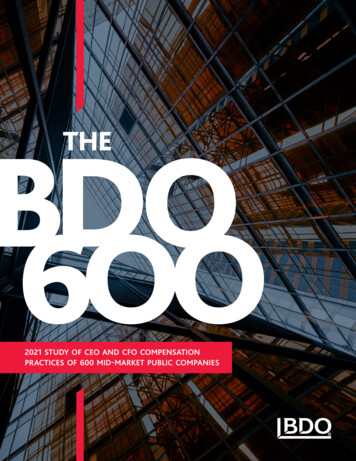
Transcription
BDO6OOTHE2021 STUDY OF CEO AND CFO COMPENSATIONPRACTICES OF 600 MID-MARKET PUBLIC COMPANIES
Table of ContentsBDO'S COMPENSATIONCONSULTING PRACTICEconsists of an experienced anddedicated team of professionalswho are committed to assistingleadership and boards withdeveloping compensationINTRODUCTION.1EXECUTIVE COMPENSATION IN A COVID-19 CLIMATE A RETROSPECTIVE.2METHODOLOGY . 4OVERALL RESULTS –SUMMARY OF FINDINGS BY COMPANY SIZE. 6strategies and programsCOMPENSATION LEVELS BY COMPANY SIZEdesigned to attract, retainSIZE GROUP A. 12and reward the executiveteam. Our services includedesigning and benchmarkingexecutive compensationprograms, including cash- andequity-based programs, boardremuneration, compensationcommittee development,SIZE GROUP B. 14SIZE GROUP C. 16OVERALL RESULTS –SUMMARY OF FINDINGS BY INDUSTRY.18COMPENSATION LEVELS BY INDUSTRYEnergy.22nonqualified and deferredFinancial Services–Banking .24compensation plans, advisingFinancial Services–Nonbanking .26on compensation-related taxand accounting issues andother related services.Healthcare and Life Sciences.28Manufacturing.30Our services are tailored,Real Estate.32scalable and designed toRetail.34accommodate the uniqueTechnology.36needs of public, private andnonprofit clients of all sizesTHOUGHT LEADERSHIP: RELATED INSIGHTS. 38including multinationalABOUT BDO'S GLOBAL EMPLOYERSERVICES PRACTICE. 40Fortune 500 companies.CONTACT US. 42and across all industries,
THE BDO 600 / 2021 Study of CEO and CFO Compensation Practices of 600 Mid-Market Public CompaniesIntroductionExecutive compensation continues to weigh heavily on the minds of most companies’leadership. External pressures scrutinizing executive pay practices continue asshareholder activists, investors and employees demand greater transparency.The ongoing quest to align compensation programs with shareholders’ value creationmetrics represents both new and ongoing challenges, especially in light of ongoingeconomic uncertainty. Designing a smart, well-balanced compensation strategyand program require careful consideration of both internal and external factors.The heightened focus on ESG (environmental, social and governance) issues is addingto the complexity along with accounting, regulatory and tax issues. These all must beevaluated alongside the effectiveness of incentive programs that are designed toreward executives for their contributions toward achieving organizational goals.The data in this report, while a snapshot in time, can be a useful benchmarking resourceto compare compensation practices of your executives to those ofcompanies in a similar industry and size range.ABOUT THE BDO 600 STUDYThis study examines the chief executive officer (CEO) and chief financial officer (CFO)compensation plans and pay levels of 600 middle market public companies, reviewsthe key components of pay packages and provides comparisons by title, companysize and industry.In fiscal year 2020,CEO Total DirectCompensation increasedby an average of12.1%.The industries included in the study are:EnergyManufacturingFinancial services–bankingReal estateFinancial services–nonbankingRetailTechnologyHealthcare and life sciencesCompanies in the six nonfinancial service industries have annual revenues between 100 million and 3 billion. Companies in the two financial service industries haveassets under management between 100 million and 6 billion. All data in our studywere extracted from proxy statements that were filed between April 2020 andMarch 2021. Consolidated proxy data were provided by Main Data Group, Inc.Our study is unique in the industry because it focuses on middle market companies;most compensation studies focus on much larger companies.In fiscal year 2020,CFO Total DirectCompensation increasedby an average of10.1%.1
2THE BDO 600 / 2021 Study of CEO and CFO Compensation Practices of 600 Mid-Market Public CompaniesExecutive Compensation in aCOVID-19 Climate - A RetrospectivePay levels increased by 12.1% for CEOs and 10.1% for CFOs between April 2020 and March 2021. Specifically, this reflects the changein 2020 total direct compensation (salaries, bonuses and long-term incentives [LTIs]) compared to 2019 as disclosed in proxies. Thisincrease is the largest of the last five years during which year-over-year changes for the CEO ranged from -1.1% to 4.7% and for theCFO ranged from 1.5% to 4.4%.This report focuses on pay levels as reported in the 2021 proxies, which reflect the compensation arrangements as influenced bythe COVID-19 environment. Last year we conducted additional research into the BDO 600 companies' 8K SEC filings, which werefiled between March and June of 2020 and found a reported 20% reduction in named executive pay levels. CEOs saw average salaryreductions of 47% for an average of five-and-a-half months. Of the organizations that announced pay cuts, 61% extended payreductions to executives beyond the C-suite. The most common reduction was between 20% and 50% of base pay. The table belowsummarizes the pay reduction actions for CEOs, CFOs and other named executive officers (NEOs).DISCLOSED 2020 SALARY REDUCTIONS OF BDO 600 COMPANIES IN RESPONSE TO COVID-19CEOCFONEOPercent disclosing salary reductions19%17%17%Median decrease-33%-20%-20%65.756Median number of months
THE BDO 600 / 2021 Study of CEO and CFO Compensation Practices of 600 Mid-Market Public CompaniesWhile it appeared that executive pay levels would decrease,upon review of the 2021 proxies, at the end of the year:XCEO salaries increased by 1.5%, total cash compensation(TCC) increased by 11% and total direct compensation(TDC) by 12%.3However, not everyone was a winner. While some companyexecutives experienced real pay cuts, generally the CEO wasthe most affected.XThe CEOs of seven companies had salary reductions of50% or more. No CFOs had salary cuts of 50% or more.CFO salaries increased by 4%, TCC increased by 8% andTDC by 10%.X76 companies did not pay their CEO a bonus, while 53 didnot pay the CFO a bonus.On average, executives appear to have profited during thepandemic; however, this year, more than ever, there werepronounced differences by industry. While retail CEOs took a hitto salary (-5%), they were overall the big winner, experiencing a20% average increase in TDC over 2019. Real estate executivestook a hit to their TCC which dropped 5.3% yet realized anoverall 9.5% increase in pay when accounting for long-termincentives and equity. Financial services–nonbanking trailed thepack with only a 5% increase in TDC.X97 CEOs received a bonus that was half or less thanthe previous year's bonus, and 72 CFOs received similarreductions in their bonuses compared to last year.X65 CEOs and 37 CFOs did not receive an equity or longterm incentive grant.XIn the end, on average, CEO TDC went up in every industryby 5%–20%.While salary reductions and lack of bonus payouts can bebolstered by large equity grants, overall, 28 CEOs had a totalpay package that was half or less than that of the prior year.Almost 40% were from energy companies; technology andretail combined made up another 40%. By comparison, 16CFOs had similar reductions to their pay package.
4THE BDO 600 / 2021 Study of CEO and CFO Compensation Practices of 600 Mid-Market Public CompaniesMethodologyThe data collected from the 600 companies in the samplerepresent the compensation policy in effect at eachcompany’s fiscal year end, as disclosed in the executivecompensation narrative in public filings. We analyzed thedata in aggregate by the standard five components ofcompensation: salary, bonuses and annual incentives,stock options, other long-term incentives (LTIs) andfull-value stock awards.Year-over-year analyses are based on the average changein overall pay levels for base salary, total cashcompensation and total direct compensation (TDC).Year-over-year changes to annual incentives are not shownbecause the results can be driven by companies’ specificsituations. For stock and other LTIs, not all CEOsor CFOs received annual stock or LTI awards. As such,year-over-year comparisons may not accurately indicatemarket trends and have been excluded.Starting in 2020, BDO updated our methodology forcalculating year-over-year pay increases. We now calculatecompany-by-company, year-over-year changes in paydata, rather than comparing year-over-year pay data basedon published reports. Each report typically represents aslightly different array of companies due to delistings,mergers and other circumstances. This year, the tablesshow the 2020 pay data and the net change in pay levels.
THE BDO 600 / 2021 Study of CEO and CFO Compensation Practices of 600 Mid-Market Public CompaniesTYPES OF COMPENSATIONXSalary is the annualized base salary.XAnnual Incentives comprise discretionary bonusesearned, as well as payments received under performancebased annual incentive (AI) plans.XTotal Cash Compensation (TCC) is salary plus any bonusor annual incentive earned.XLong-Term Incentives (LTI) are the total long-termincentive including stock options, full-value stock awardsand other LTIs. Stock Options are the grant date fair value awards asreported by each company. Full-Value Stock Awards data include both stockand stock unit awards. The grant date fair value of theawards was used in this analysis. Irregular grants havebeen annualized. XOther Long-Term Incentives refer to paymentsreceived under LTI plans such as cash-based LTIs.Total Direct Compensation (TDC) represents the sumof salary, annual incentives, stock options, full-value stockawards and other LTIs for each incumbent.SCOPE FACTORSCompensation levels and program design features for theCEOs and CFOs are organized by company size andindustry. The results can be benchmarked by either of thesefactors to obtain different perspectives on pay levels andcompensation practices.5COMPANY SIZEMost traditional executive compensation studies useannual revenues, or assets in the case of financial servicesinstitutions, as the primary scope factor because of the wellestablished and direct correlation between company size andexecutive compensation.Our study reports compensation for three groups ofcompanies based on size:SizeCategoryRevenueRangeAsset Range(Financial Services)Group A 100 million – 500 million 100 million – 1.25 billionGroup B 500 million – 1.25 billion 1.25 billion – 2.5 billionGroup C 1.25 billion – 3 billion 2.5 billion – 6 billionINDUSTRYThis study also reports the pay levels and compensationpractices for CEOs and CFOs for companies in eight industries.XEnergyXManufacturingXFinancial services–bankingXReal estateXRetailXTechnologyXFinancial services–nonbankingXHealthcare and lifesciencesADDITIONAL NOTES ON THE STUDYIn cases where there was more than one CEO or CFO at a company within the fiscal year, we used the compensation for theincumbent who occupied the position for the majority of the fiscal year.To establish a common comparative base for all 600 companies in the study sample, we used a consistent methodology to valuecompensation levels, including annualizing salary data as appropriate. If a company could not be brought into parity with othercompanies in the sample, then that company was excluded from the sample and replaced with a similar company to obtain arepresentative sample across industries and company size.
6THE BDO 600 / 2021 Study of CEO and CFO Compensation Practices of 600 Mid-Market Public CompaniesSUMMARY OF FINDINGS BY COMPANY SIZEOverall ResultsOVERALL RESULTS - TOTAL DIRECT COMPENSATION 4,500,000 4,000,000 3,500,000 3,000,000 12.1% 10.1% 2,500,000 2,000,000 1,500,000 1,000,000 500,000 0FY 2020FY 2020CEOCFOSalaryAILTIKey findings from our analysis of CEO and CFO compensation based on company size include:1. In aggregate, CEOs and CFOs experienced significantpay increases of 12.1% and 10.1%, respectively.These increases consisted of salary increases, annualincentives and LTIs.2. When comparing year-over-year change, CEOs and CFOsexperienced the following increases:XCEOs were provided salary increases of 1.5% on average,which is lower than the typical merit increases ofapproximately 3%, while total cash increased by 10.5%and LTIs by 9.4%.XCFOs received salary increases of 4.0% on average, whiletotal cash increased by 8.1% and LTIs increased by 8.8%.
THE BDO 600 / 2021 Study of CEO and CFO Compensation Practices of 600 Mid-Market Public Companies73. Pay continues to be highly correlated with company size. As the chart below illustrates, a positive correlation exists betweenCEO and CFO compensation and company size.Average CEO TDC ranges from 2,589,700 for companies in the smallest size category1 (Group A) to 5,617,558 for companiesin the largest size category2 (Group C). Average CFO TDC ranges from 1,179,709 for companies in Group A to 2,271,036 forcompanies in Group C.OVERALL RESULTS BY COMPANY SIZE 6,000,000 5,000,000 4,000,000 3,000,000 2,000,000 1,000,000Group AGroup B 0Group CGroup ACEOGroup BCFOSalaryAI1 100 million– 500 million revenues and 100 million– 1.25 billion in assets (financial services).2 1.25 billion– 3 billion revenues and 2.5 billion– 6 billion in assets (financial services).LTIGroup C
8THE BDO 600 / 2021 Study of CEO and CFO Compensation Practices of 600 Mid-Market Public Companies4. Mid-size company CEOs andCFOs had the largest payincreases: CEOs in Size Group B3experienced the largest increasein pay (14.1%) while CEOs in SizeGroup C experienced a 10.5%increase. Pay moved up 11.8%year over year for CEOs of thesmallest companies in the sample(Size Group A). CFO pay alsoincreased across all groups;Size Group B had the largestincrease of 13.6%, and A and Cexperienced similar increases,8.4% and 8.1% respectively.YEAR-OVER-YEAR CHANGE IN TDC11.8%Group A14.1%Group B8.4%Group C8.1%Group ACEOGroup BGroup CCFOGroup A5. CFO pay levels are less thanhalf of CEO pay levels:Pay levels for CFOs areapproximately 43% of CEO payfor the companies in our sample.The following graph presents acomparison of median CFO TDCto median CEO TDC for allcompanies and by company size.13.6%10.5%Group BGroup CCFO TDC AS % OF CEO TDC45.6%43.1%42.6%40.4%Group A3 500 million– 1.25 billion and 1.25 billion– 2.5 billion in assets (financial services).Group BGroup CAll
THE BDO 600 / 2021 Study of CEO and CFO Compensation Practices of 600 Mid-Market Public Companies6. Full-value shares dominate LTIs:Stock options continue to be onlya small fraction of the LTI mix, asmost companies regardless of sizeopted to give both CEOs and CFOsfull-value stock.9MIX OF LTIS1%2%86%88%12%11%CEOCFOOptionsFull ValueOther LTI7. Larger companies place the greatest percentage of pay at risk: The graph below illustrates that approximately 80% of thepay for CEOs was in the form of incentive compensation. Variable compensation for both CEOs and CFOs increased in tandemwith company size.PAY MIX BY COMPANY SIZE60%64%52%65%56%59%20%20%30%24%21%Group AGroup BGroup C18%18%19%20%22%17%14%Group AGroup BGroup CCEOCFOSalaryAILTI
10THE BDO 600 / 2021 Study of CEO and CFO Compensation Practices of 600 Mid-Market Public CompaniesOVERALL RESULTS / CEOThe following chart indicates the composition of TDC for CEOs. The LTI component represents well over 50% of the totalcompensation package which reflects the need for alignment with the shareholders and a long-term perspective.Salary 702,70417%CEOLTI 2,702,043ALL COMPANIESCOMBINED63%AI 833,38920%The table below summarizes average pay for CEOs in 2020 and the percentage increase or decrease for base salary, total cashcompensation and TDC. TDC for CEOs increased by 12.1%.PositionBase SalaryAnnual IncentivesTotal CashCompensationLong-TermIncentivesTotal DirectCompensationCEO 702,704 833,389 1,536,093 2,702,043 4,238,136Change overPrior Year1.5%—10.5%—12.1%COMPENSATION MIXThe compensation mix has remained consistent over the last several years. The average compensation mix for CEOs in 2020continues to favor LTIs. The majority of equity value provided to both CEOs and CFOs was delivered through full-value stock awards.
THE BDO 600 / 2021 Study of CEO and CFO Compensation Practices of 600 Mid-Market Public Companies11OVERALL RESULTS / CFOSalary 425,44724%CFOLTI 1,026,221ALL COMPANIESCOMBINED56%AI 352,50120%The table below summarizes average pay for CFOs and the change from fiscal year 2019 to 2020 for three pay components. TDC forthe CFO position increased by 10.1%.PositionBase SalaryAnnual IncentivesTotal CashCompensationLong-TermIncentivesTotal DirectCompensationCFO 425,447 352,501 777,948 1,026,221 1,804,169Change overPrior Year4.0%—8.1%—10.1%COMPENSATION MIXCompared to CEOs, CFOs’ average compensation mix in 2020 was more evenly split between cash and LTIs/equity with equity beingslightly higher than cash.The remainder of this study presents results by company size and industry.
12THE BDO 600 / 2021 Study of CEO and CFO Compensation Practices of 600 Mid-Market Public CompaniesCOMPENSATION LEVELS BY COMPANY SIZEOverall ResultsSalary 572,18222%CEOSIZE GROUP ALTI 1,542,570 100 million – 500 million*60%AI 474,94818%The average compensation paid to CEOs of the smallest-sized companies for fiscal year 2020 and the change of three componentsover 2019 is listed below.PositionBase SalaryAnnual IncentivesTotal CashCompensationLong-TermIncentivesTotal DirectCompensationCEO 572,182 474,948 1,047,130 1,542,570 2,589,700Change overPrior Year1.0%—5.4%—11.8%COMPENSATION MIXCEOs in Size Group A received 40% of their compensation through salary and annual incentives and 60% through equity and LTIs.*Revenue range: 100 million– 500 million; asset range (financial services): 100 million– 1.25 billion.
THE BDO 600 / 2021 Study of CEO and CFO Compensation Practices of 600 Mid-Market Public CompaniesSalary 354,10130%CFOLTI 614,174SIZE GROUP A52% 100 million – 500 million*AI 211,43418%The average compensation paid to CFOs of the smallest sized companies for fiscal year 2020 is provided in the table below.PositionBase SalaryAnnual IncentivesTotal CashCompensationLong-TermIncentivesTotal DirectCompensationCFO 354,101 211,434 565,535 614,174 1,179,709Change overPrior Year3.7%—5.6%—8.4%COMPENSATION MIXCFOs in this group received slightly less than half (48%) of their pay in cash in 2020.*Revenue range: 100 million– 500 million; asset range (financial services): 100 million– 1.25 billion.13
14THE BDO 600 / 2021 Study of CEO and CFO Compensation Practices of 600 Mid-Market Public CompaniesSalary 704,15617%CEOSIZE GROUP BLTI 2,640,443 500 million– 1.25 billion*64%AI 802,52619%The average compensation paid to CEOs of mid-sized companies for fiscal year 2020 is listed in the table below. The year-over-yearincrease in CEOs’ TDC was driven in part by increases in total cash compensation.PositionBase SalaryAnnual IncentivesTotal CashCompensationLong-TermIncentivesTotal DirectCompensationCEO 704,156 802,526 1,506,682 2,640,443 4,147,125Change overPrior Year0.3%—13.7%—14.1%COMPENSATION MIXCEOs in this group have a slightly higher percentage of compensation paid through LTIs than the smaller companies in Size Group A.* Revenue range: 500 million– 1.25 billion; asset range (financial services): 1.25 billion– 2.5 billion.
THE BDO 600 / 2021 Study of CEO and CFO Compensation Practices of 600 Mid-Market Public CompaniesSalary 427,42724%CFOSIZE GROUP BLTI 1,006,886 500 million– 1.25 billion*56%AI 354,17020%The average compensation paid to CFOs of mid-sized companies for fiscal year 2020 is listed in the table below.PositionBase SalaryAnnual IncentivesTotal CashCompensationLong-TermIncentivesTotal DirectCompensationCFO 427,427 354,170 781,597 1,006,886 1,788,483Change overPrior Year3.9%—10.7%—13.6%COMPENSATION MIXLTIs and equity for CFOs comprise slightly over half of their TDC.* Revenue range: 500 million– 1.25 billion; asset range (financial services): 1.25 billion– 2.5 billion.15
16THE BDO 600 / 2021 Study of CEO and CFO Compensation Practices of 600 Mid-Market Public CompaniesSalary 804,01414%CEOLTI 3,670,091AI 1,143,45220%SIZE GROUP C 1.25 billion– 3 billion*66%The average compensation paid to CEOs of the largest companies in our sample for fiscal year 2020 is listed in the table below. CEOsin this group saw the smallest increase in TDC over the last year.PositionBase SalaryAnnual IncentivesTotal CashCompensationLong-TermIncentivesTotal DirectCompensationCEO 804,014 1,143,452 1,947,466 3,670,091 5,617,558Change overPrior Year2.8%—11.6%—10.5%COMPENSATION MIXThe CEOs in this group received 34% of their pay in cash and 66% in LTIs.*Revenue range: 1.25 billion– 3 billion; asset range (financial services): 2.5 billion– 6 billion.
THE BDO 600 / 2021 Study of CEO and CFO Compensation Practices of 600 Mid-Market Public CompaniesSalary 475,42421%CFOSIZE GROUP CLTI 1,342,294 1.25 billion– 3 billion*59%AI 453,31820%The average compensation paid to CFOs of the largest companies in our sample for fiscal year 2020 is listed in the table below.PositionBase SalaryAnnual IncentivesTotal CashCompensationLong-TermIncentivesTotal DirectCompensationCFO 475,424 453,318 928,742 1,342,294 2,271,036Change overPrior Year4.2%—7.5%—8.1%COMPENSATION MIXCFOs’ LTI component comprised 59% of total pay in 2020.*Revenue range: 1.25 billion– 3 billion; asset range (financial services): 2.5 billion– 6 billion.17
18THE BDO 600 / 2021 Study of CEO and CFO Compensation Practices of 600 Mid-Market Public CompaniesCOMPENSATION LEVELS BY INDUSTRYOverall ResultsOVERALL RESULTS BY INDUSTRY 6,000,000 5,000,000 4,000,000 3,000,000 2,000,000 1,000,000 0CEO CFOCEO CFOCEO CFOEnergyFin. Serv.–BankingFin. Serv.–NonbankingSalaryCEO CFOCEO CFOHealthcare Manufacturing& LifeSciencesAICEO CFOCEO CFOCEO CFORealEstateRetailTechnologyLTIFor middle market companies, industry is just as important as company size for benchmarking CEO and CFO compensation. Asindicated in the chart above, CEO and CFO compensation levels vary considerably by industry.
THE BDO 600 / 2021 Study of CEO and CFO Compensation Practices of 600 Mid-Market Public CompaniesCHANGES TO CEO COMPENSATIONCHANGES TO CFO COMPENSATIONCEOs in the retail industry experienced the largest year-overyear increase in average TDC (19.9%), followed by healthcareand life sciences with a 16.6% increase. Retail CEOs wentfrom seeing a 6.7% increase last year to a 19.9% growth dueto better-than-expected performance in 2020. As we emergefrom the global pandemic, retail is growing at levels not seenin over 15 years.4Retail industry CFOs experienced the largest percentageincrease on average in TDC (19.6%). Technology industryCFOs saw a 16.1% increase, while energy industry CFO TDCremained almost level with a 0.1% increase.Following closely behind healthcare and life sciences,manufacturing industry CEOs experienced a 16.3% increase.No industries experienced a decrease, though financialservices-nonbanking saw the smallest increase at 5.2%.Average compensation varies widely from 5,705,272 forhealthcare and life sciences industry CEOs to 1,036,516 forCEOs in the financial services–banking industry. Our findingsreveal that companies in the financial services–bankingindustry favor cash over equity, with a compensation mix of76% cash and 24% equity/LTIs. Other industries feature amore evenly split compensation mix between annual cashand equity/LTIs.Technology CFOs have the highest average compensation at 2,789,183; CFOs of financial services-banking companies fallon the lowest end at 489,028. The industry variation in CFOcompensation mix is similar to that of CEOs. Companies in thefinancial services–banking industry favor cash over equity, witha compensation mix of 81% cash and 19% equity/LTIs. Otherindustries feature a more balanced mix of pay between annualcash and equity/LTIs. Full-value stock awards are favored overstock options for companies across all industries.YEAR-OVER-YEAR CHANGE IN TDC19.9% 11.0%9.5%6.1%0.1%CEOCFOEnergy4CEOCFOFin. Serv.–BankingCEOCFOFin. /state-retailCEOCFOHealthcare& EOCFORetailCEOCFOTechnologyRetailindustry CEOs andCFOs both saw thehighest increase in TDC comparedto all other industries studied.
20THE BDO 600 / 2021 Study of CEO and CFO Compensation Practices of 600 Mid-Market Public CompaniesPAY MIX BY INDUSTRYCEO CFOCEO CFOCEO CFOCEO CFOCEO CFOCEO CFOCEO CFOCEO CFOEnergyFin. Serv.BankingFin. Serv.NonbankingHealthcare& ySalaryAILTI
THE BDO 600 / 2021 Study of CEO and CFO Compensation Practices of 600 Mid-Market Public Companies21CFO TDC AS % OF CEO TDC46%50%47%44%40%EnergyFin. Serv.BankingFin. Serv.Nonbanking37%37%38%Healthcare &Life SciencesManufacturingRealEstateRetailTechnologyThe relationship of CFO to CEO pay varies somewhat by industry. The biggest gap is found in the financial services–nonbanking,healthcare and life sciences, manufacturing, and real estate industries, where CFOs earn about 38% of the CEOs’ average TDC.CFOs in the technology industry are the most well-paid as a percentage of CEO compensation, earning 50% of what CEOs make inother industries.
22THE BDO 600 / 2021 Study of CEO and CFO Compensation Practices of 600 Mid-Market Public CompaniesCOMPENSATION LEVELS BY INDUSTRYEnergySalary 699,47118%CEOAI 832,46121%LTI 2,428,90061%At one time, energy industry CEOs reported the highest average compensation across industries. However, in recent years, energyindustry CEO compensation levels have fallen behind healthcare and life sciences, technology, real estate, financial services–nonbanking and manufacturing. In 2020, energy industry CEOs experienced a 6.5% increase in pay from the prior year, the secondlowest of all industries.PositionBase SalaryAnnual IncentivesTotal CashCompensationLong-TermIncentivesTotal DirectCompensationCEO 699,471 832,461 1,531,932 2,428,900 3,960,831Change overPrior Year2.3%—7.7%—6.5%
THE BDO 600 / 2021 Study of CEO and CFO Compensation Practices of 600 Mid-Market Public Companies23Salary 409,57922%CFOLTI 1,061,24658%AI 370,45720%In contrast to CEO compensation in the energy industry, which saw a 6.5% increase in total pay, CFO pay only rose 0.1%.PositionBase SalaryAnnual IncentivesTotal CashCompensationLong-TermIncentivesTotal DirectCompensationCFO 409,579 370,457 780,036 1,061,246 1,841,281Change overPrior Year1.6%—2.4%—0.1%Energy industry executives recognize the struggles the industry has faced during the pandemic, with lowerdemand and lower commodity prices. Executives will need to continue their efforts to strengthen balancesheets and deliver on promises of return of capital to investors before a rise in compensation levels occurs.Stronger and stable commodity prices combined with increasing demand will aid those efforts as the industryas a whole begins to rebound.CLARK SACKSCHEWSKYU.S. Natural Resources Industry Leader, Tax Market Leader
24THE BDO 600 / 2021 Study of CEO and CFO Compensation Practices of 600 Mid-Market Public CompaniesCOMPENSATION LEVELS BY INDUSTRYFinancial Services–BankingLTI 241,48524%CEOAI 282,750Salary 512,28149%27%Financial services-banking institutions provide the highest percentage of compensation in terms of salary and annual incentivesamong all industries studied. Average CEO and CFO compensation levels, however, remain the lowest of all industries included in ourstudy. In 2020, CEO pay levels climbed 8.7%.PositionBase SalaryAnnual IncentivesTotal CashCompensationLong-TermIncentivesTotal DirectCompensationCEO 512,281 282,750 795,031 241,485 1,036,516Change overPrior Year5.3%—8.1%—8.7%
THE BDO 600 / 2021 Study of CEO and CFO Compensation Practices of 600 Mid-Market Public CompaniesLTI 92,4642519%CFOAI 111,412Salary 285,15258%23%The average TDC paid to CFOs of companies in the financial services-banking industry for fiscal year 2020 is listed below.PositionBase SalaryAnnual IncentivesTotal CashCompensationLong-TermIncentivesTotal DirectCompensationCFO 285,152 111,412 396,564 92,464 489,028Change overPrior Year6.3%—7.0%—7.2%Compensation grew significantly for C-suite executives in the financial services–banking industry as banks wereheavily relied upon due to the pandemic, operating as essential busine
CEOs saw average salary reductions of 47% for an average of five-and-a-half months. Of the organizations that announced pay cuts, 61% extended pay . These increases consisted of salary increases, annual CEO CFO . THE BDO 600 / 2021 Study of CEO and CFO Compensation Practices of 600 Mid-Market Public Companies. THE BDO 600 / 2021 Study of CEO .


